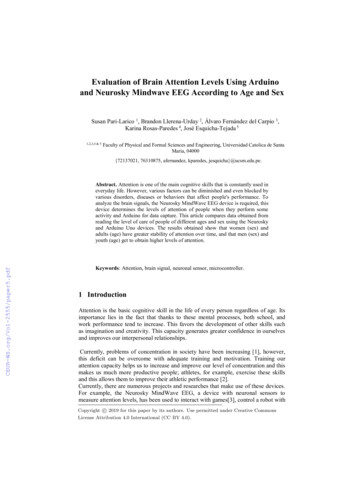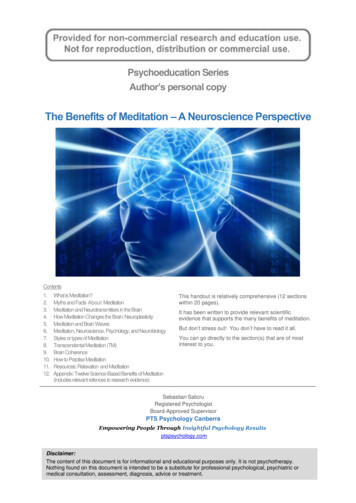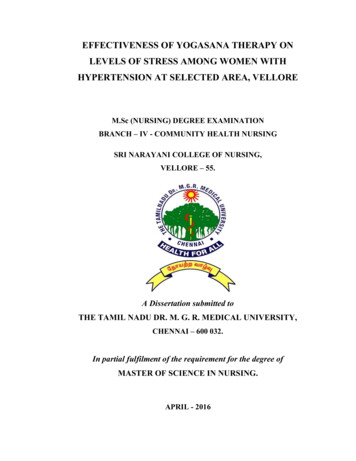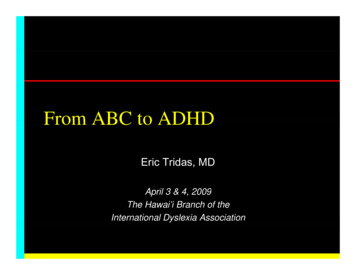
Transcription
Evaluation of Brain Attention Levels Using Arduinoand Neurosky Mindwave EEG According to Age and SexSusan Pari-Larico 1, Brandon Llerena-Urday 2, Álvaro Fernández del Carpio 3,Karina Rosas-Paredes 4, José Esquicha-Tejada 51,2,3,4 & 5Faculty of Physical and Formal Sciences and Engineering, Universidad Catolica de SantaMaria, 04000{72137021, 76310875, afernandez, kparedes, jesquicha}@ucsm.edu.pe.Abstract. Attention is one of the main cognitive skills that is constantly used ineveryday life. However, various factors can be diminished and even blocked byvarious disorders, diseases or behaviors that affect people's performance. Toanalyze the brain signals, the Neurosky MindWave EEG device is required, thisdevice determines the levels of attention of people when they perform someactivity and Arduino for data capture. This article compares data obtained fromreading the level of care of people of different ages and sex using the Neuroskyand Arduino Uno devices. The results obtained show that women (sex) andadults (age) have greater stability of attention over time, and that men (sex) andyouth (age) get to obtain higher levels of attention.Keywords: Attention, brain signal, neuronal sensor, microcontroller.1 IntroductionAttention is the basic cognitive skill in the life of every person regardless of age. Itsimportance lies in the fact that thanks to these mental processes, both school, andwork performance tend to increase. This favors the development of other skills suchas imagination and creativity. This capacity generates greater confidence in ourselvesand improves our interpersonal relationships.Currently, problems of concentration in society have been increasing [1], however,this deficit can be overcome with adequate training and motivation. Training ourattention capacity helps us to increase and improve our level of concentration and thismakes us much more productive people; athletes, for example, exercise these skillsand this allows them to improve their athletic performance [2].Currently, there are numerous projects and researches that make use of these devices.For example, the Neurosky MindWave EEG, a device with neuronal sensors tomeasure attention levels, has been used to interact with games[3], control a robot withCopyright c 2019 for this paper by its authors. Use permitted under Creative CommonsLicense Attribution 4.0 International (CC BY 4.0).
the mind[4], improve the concentration of children with autism[5], assess attentionlevels in children [8], among others. On the other hand, the Arduino device, a platewith a microcontroller that reads sensors and allows digital and interactive devices tobe built, has been used in education [6], in improving the quality of life of adults andpeople with disabilities [7], in the development of a fire alarm system [8], and so on.This research has as objective integrate two devices, the Arduino and the NeuroskyMindWave EEG to measure the level of attention of the person using it. The collecteddata are stored in a spreadsheet, and in real-time a graph of lines is generated,according to the concentration values, to obtain the patterns according to each profile.This article shows in the second section the related works, in the third section theapplied methodology, in the fourth section it shows the development of the projectand the statistics obtained from different samples, the results and discussions arepresented in the fifth section, and finally the conclusions.2 Related workResearch works focused on identifying the level of attention have been of interest formany researchers. Several training programs are used to enhance memory capabilitiesin childrens. In [9], a type of sensors called “neurosky” is applied to analysis brainwaves. This device determines the attention levels when people are doing someactivity. The results present scores achieved by each person regarding attention andmeditation levels through a daily scanner using the WinWave device.In [10], a device based on Brain Computer Interface (BCI) or also called MindMachine Interface (MMI) was developed for instrumenting the meditation andattention level of human brain. The mindwave mobile headset captures electrical signsfrom the brain and identifies thoughts and emotional states, and also gives informationon the brainwave frequency bands. Results of experiments show differences ofattention between girls and boys when doing similar activities, but girls have highermeditation level when solving problems.The Neurosky’s MindWave device is used in [11] for detecting attention levels whenstudies do multiple readings. Some interesting results show that students presentedbetter attention levels when information is presented in the format of Power Point anddigital maps in real classroom activities.The alpha and beta waves in human brains generally determine the attention level, butit can be affected when moods turn from normal to stress. These variations and theireffect on level attention is researched in [12], also taking into account the age and sex.Results demonstrated that with the normal mood a better concentration can be achievedthan with a stressed mood, and that girls generally show more attention level than theboys.In conclusion, the measurement of the brain signs using different kind of devices haveas main goal identify the mental level in order to make corrective actions in restoringthe level attention. The researchers propose the use of Arduino together with similardevices identified in the research works as a contribution to enhance the researches inthis area.
3 MethodologyThe development of the proposal consists of 4 stages: Proposal design. - A design was made about the integration of the differentdevices, to achieve the objective of obtaining the reading data of the differentpeople. Development of the proposal. - It consisted of programming the Arduinomicrocontroller and configuring the Bluetooth HC 05 and the Neurosky MindWaveEEG. Tests of the proposal. - To test the proposal, the level of attention to differentpersons of age and sex was read. Interpretation of results. -Through the data obtained, it was possible to rescuepatterns according to the profiles of people and establish comparisons with otherrelated research.4 Project DevelopmentTo capture the data we used an Arduino Uno board, a Bluetooth HC-05 to connectArduino to MindWave, a 2X16 LCD screen, and 3 LEDs (red, yellow and green) thatwill light up depending on the level of attention. The elements and actions carried outin the project are described below:4.1 Connection LCD screen 2X16 I2CThis is a device that allows the user's attention level values to be displayed whenusing the MindWave [11]. The connection of this device to the Arduino board isshown in Table 1.Table 1. Arduino-LCD Display Connection.ArduinoLCD ScreenGNDGNDVCC5VSDAA4SCLA5Sometimes, even if all pins are connected correctly, the display does not showvalues. This is because the potentiometer of the device must be calibrated for itsintensity. To solve this problem, turn the potentiometer until the desired result isobtained.
4.2 Connection and configuration of Bluetooth module HC-05There are several models and versions of the HC-05 module. Its main feature is thatit has a push-button that will serve to enter AT Mode and then configure it. [13].The configuration of the Bluetooth module is described in the following steps:Step 1: Connection. - The connection of the HC-05 to the Arduino board isshown in Table 2.Table 2. Arduino-LCD Display ConnectionArduinoGNDVCCRXTXHC-5GND5VRXTXThere are some models where the connection is RX TX and TX RX.Step 2: Enter AT mode. - After making the connection, you have to load asketch in Arduino. Before connecting the Arduino board to the computer, theHC-05 pushbutton must be held down while connecting to the PC until theBluetooth module LED turns on and off intermittently, indicating that it is in ATmode.Step 3: Configuration. - Once the previous step has been completed, theArduino serial is opened and the options "38400 baud" and "Both NL & CR" arechanged. This will allow you to enter AT commands, which are shown in Fig. 1.These commands allow you to configure the Bluetooth module to connect to theMindWave.Fig. 1. AT- Commands4.3 Integration of all devicesOnce the HC-05 and the LCD are connected and configured, 3 LEDs (red, yellowand green) are added, as shown in the final diagram (see Fig. 2).
Fig. 2.Final Scheme4.4 Program CodingThe code sketch included the LiquidCrystal I2C.h and Wire.h libraries, this tovisualize the level of attention of the person through the LCD screen.The following code allows you to display the user's level of quality and attention onthe Arduino serial, as well as to display the level of attention on the LCD screen.Serial.print("PoorQuality: ");Serial.print(poorQuality, DEC);Serial.print(" Attention: ");Serial.print(attention, DEC);/////////////////////////////lcd.setCursor(0, /////////////////Serial.print(" Time since last packet: ");Serial.print(millis() - lastReceivedPacket, DEC);lastReceivedPacket millis();Serial.print("\n");Finally, care ranges were implemented, ranging from 0 to 100, with 0 to 40considering a low level, 40 to 70 intermediate and 70 to 100 high. Depending on thelevel of attention, the red, yellow and green LEDs will be illuminated accordingly (seenext code).if(attention 40 && attention 0)
{digitalWrite(GREENLED1, LOW);digitalWrite(YELLOWLED1, LOW);digitalWrite(REDLED1, HIGH);}if(attention 71 && attention 39){digitalWrite(GREENLED1, LOW);digitalWrite(YELLOWLED1, HIGH);digitalWrite(REDLED1, LOW);}if(attention 101 && attention 70){digitalWrite(GREENLED1, HIGH);digitalWrite(YELLOWLED1, LOW);digitalWrite(REDLED1, LOW);}4.5 Compilation of the experimentThe steps to follow to compile the program are the following:- Make sure that the connections are correctly located.- Connect the Arduino board to the computer.- Disconnect the RX from the Arduino board with the HC-05 TX.- Compile the sketch.- Open the serial with 57600 bauds.- Place the MindWave on the head.- Wait a few seconds and switch on the MindWave- The Arduino board and the MindWave must be connected automatically (if thisis not the case, press upwards for 3 seconds until the headset light and the LED ofthe Bluetooth module stop flashing).- Reconnect the Arduino RX with the HC-05 TX.- Check the variation of the LEDs concerning their level of attention.- Observe the attention level on the LCD screen.The complete code can be located at [14].
4.6 Data capture in an Excel fileThe data capture was worked based on an excel sheet developed by [15] that consistsof the reading of the incoming values by the serial port of the computer. This filemakes use of the library created by David M. Hitchner and adapted to work with 64bits by Hal Evensen[16].The main modification to the file is in the code linked to the "Open Port" button (seenext code) since it was originally made to work with 9600 bauds, but as we remember,our program works at 57600.Private Sub Open Port Click()Dim ID Port As Integer ' Choice of port COM1 to COM4.Dim State As Long 'Returns 0 if there have been no errorID Port 3' COM3 port is established.' The port is opened with the following characteristics.' Retry action is not implemented.State CommOpen(ID Port, "COM" & CStr(ID Port),"baud 57600 parity N data 8 stop 1")With the addition of this file in the project, the sketch code shown above must bemodified so that only the value of the "attention" variable is displayed by the serial.Afterward, just connect the Arduino to the computer (the previously compiled programis already stored in the Arduino memory). You must select the button "Open Port" andthen "Read Port", and you will see how the values of the table and the graph aremodified by capturing the level of attention through the Mindwave.5 Results and DiscussionFor this research, a level of care test was done on 46 people, of whom 20 were menand 26 women; and in turn, xz is a common factor to which people are subjected, evenin their hours of study, at the end a test of compression of what they had read.5.1 Comparison of data by sexAccording to the data obtained (See Fig. 3a), it is appreciated that men reach higherlevels of attention, but over time these go down. On the other hand, although womendo not get high levels of attention, it remains more constant. A normal distribution wasobserved for each group (Kolmogorov-Smirnov test: p 0.05). The average value ofmen is statistically significantly higher than the women’s value (t test, p 0.05) (SeeFig. 3b)
SexM enW om en406080A v e ra g ea)b)Fig. 3. Results by sex. a. Time series analysis b. Box and whiskers analysis5.2 Comparison of data by ageThe results obtained are shown in (Fig. 4a). It can be seen that although the minorswere very enthusiastic about trying the experiment and could reach good levels ofattention, the values were very unstable. On the other hand, young people had thepossibility of having a higher level of attention, but these values decreased with time,presenting a bit of instability. Finally, the values show that adults were the most stableduring the evaluation time. A normal distribution was observed in two groups (minorsand young people). Adult data had a non-normal distribution. The analysis showedstatistically significant differences between the groups (Kruskal-Wallis test, p 0.05).Young people have a higher average than the minors (p 0.05). Adults have a higheraverage than the minors (p 0.05). No statistically significant differences were foundbetween adults and young people average (p 0.05) (See Fig. 4b).a)b)Fig. 4. Results by age. a.Time serie analysis. b. Box and whiskers analysis
The results show that students lose attention levels over school hours, being similar tothe results in men and young adults people, who low their attention level over time.When students are training to improve their attention, it comes with constant values.The attention of the children when they read a book reaches an average of 51. Finally,in the tests carried out, the existence of small-time ranges was appreciated wherepeople low their level of attention, maybe due to the emotion that can be transmittedwhen reading a book.6 ConclusionsThe Arduino and Neurosky MindWave EEG allowed us, with a low cost, to carry outan in-depth evaluation of how people's attention changes according to age or sex, thisrequired a spreadsheet that collects the samples sent by Arduino.The fundamental cognitive ability in the life of the human being is the attention, thisone favors the yield and personal development. This cognitive ability varies accordingto the age or sex of the human being, as expressed in this research.Males tend to have high levels of attention compared to females, however, thisdecreases over time. On the other hand, women's attention tends to remain constant.Based on age, the level of attention in children often varies being unstable, youngpeople have a level of attention, but little by little this decreases. In contrast, adultsmaintain a constant level of attentionWith this research, you have the basis to perform various tests in different situationsthat know if a human being is attentive, in future research you will have more detail todevelop new methodologies of how to improve education according to age and sex.AcknowledgmentsThe authors express their gratitude to the Vice-rectorate of Research of theUniversidad Catolica de Santa María for the opportunity to develop this research usingResolution 24710-R-2017.References1. “Celulares en adolescentes incrementa riesgo de déficit de atención”, Diario el comercio,2018. [Online]. Disponible en: go-deficit-atencion-noticia-537266
2. Mora Mérida, J. Zarco Resa and M. Blanca Mena, “Atención-concentración comoentrenamiento para la mejora del rendimiento deportivo en jugadores profesionales defútbol”, Revista de psicología del deporte, vol.10, no. 1, pp. 0049-65, 20013. Szajerman, D., Warycha, M., Antonik, A., & Wojciechowski, A. (2017). Popular BrainComputer Interfaces for Game Mechanics Control. In A. Zgrzywa, K. Choroś, & A.Siemiński (Eds.), Multimedia and Network Information Systems: Proceedings of the 10thInternational Conference MISSI 2016, pp. 123–134. Cham: Springer International -2 114. Katona, J., Ujbanyi, T., Sziladi, G., & Kovari, A. (2016). Speed control of Festo Robotinomobile robot using NeuroSky MindWave EEG headset based brain-computer interface. 20167th IEEE International Conference on Cognitive Infocommunications (CogInfoCom),(CogInfoCom), 000251–000256. https://doi.org/10.1109/CogInfoCom.2016.7804557/5. Dang, X., Wei, R., & Li, G. (2016). An efficient movement and mental classification forchildren with autism based on motion and EEG features. Journal of Ambient Intelligence6. Jamieson, P., & Herdtner, J. (2015). More missing the Boat - Arduino, Raspberry Pi, andsmall prototyping boards and engineering education needs them. Proceedings - Frontiers inEducation Conference, FIE, 2014. https://doi.org/10.1109/FIE.2015.73442597. Mirza, I. A., Tripathy, A., Chopra, S., D’sa, M., Rajagopalan, K., D’souza, A., & Sharma, N.(2015). Mind-controlled wheelchair using an EEG headset and Arduino microcontroller. InProceedings - International Conference on Technologies for Sustainable Development,ICTSD 2015. https://doi.org/10.1109/ICTSD.2015.70958878. Bin Bahrudin, M. S., Kassim, R. A., & Buniyamin, N. (2013). Development of Fire alarmsystem using Raspberry Pi and Arduino Uno. 2013 International Conference on 950409. Lancheros-Cuesta, D. J., Arias, J. L. R., Forero, Y. Y., & Duran, A. C. (2018). Evaluation ofe-learning activities with NeuroSky MindWave EEG [Evaluación de actividades e-learningcon NeuroSky MindWave EEG]. Iberian Conference on Information Systems andTechnologies, CISTI, 2018–June, 1–6. https://doi.org/10.23919/CISTI.2018.839931610. Nanda, P. P., Rout, A., Sahoo, R. K., & Sethi, S. (2017). Work-in-Progress: Analysis ofMeditation and Attention Level of Human Brain. In 2017 International Conference onInformation Technology (ICIT) (pp. 46-49). IEEE.11. Sezer A., Inel Y., Cagdas A. & Ulucinar U. An investigation of University Students’Attention Levels in Real Classroom Settings with Neurosky’s MindWave Mobile(EEG)Device, International Educational Technology Conference, 2015.12. Anand, A., Ray, L. S. S., Sahoo, R. K., & Sethi, S. (2019). Analysis of Attention Level ofHuman Body in Different Forms. In Emerging Technologies in Data Mining and InformationSecurity (pp. 23-32). Springer, Singapore.13. “HC-05 Bluetooth Module Pinout, Specifications, Default Settings, Replacements ooth-module14. “brandon305/Arduino MindWave”, GitHub, 2018. [Online]. Disponible en:https://github.com/brandon305/Arduino Mindwave.15. “Cómo Enviar Datos De Arduino A Excel En Tiempo Real”, EducaChip, 2016. [Online].Disponible en: cel-tiempo-real/.16. “Sample files for VBA instrument communication”, People.uwplatt.edu. [Online].Disponibleen:http://people.uwplatt.edu/ evensenh/Hal Evensens Homepage/VBA Communication.html.
Step 1: Connection. - The connection of the HC -05 to the Arduino board is shown in Table 2. Table 2. Arduino -LCD Display Connection Arduino HC -5 GND GND VCC 5V RX RX TX TX There are some models where the connection is RX Æ TX and TX Æ RX. Step 2: Enter AT mode. - After making the connection, you have to load a sketch in Arduino.











